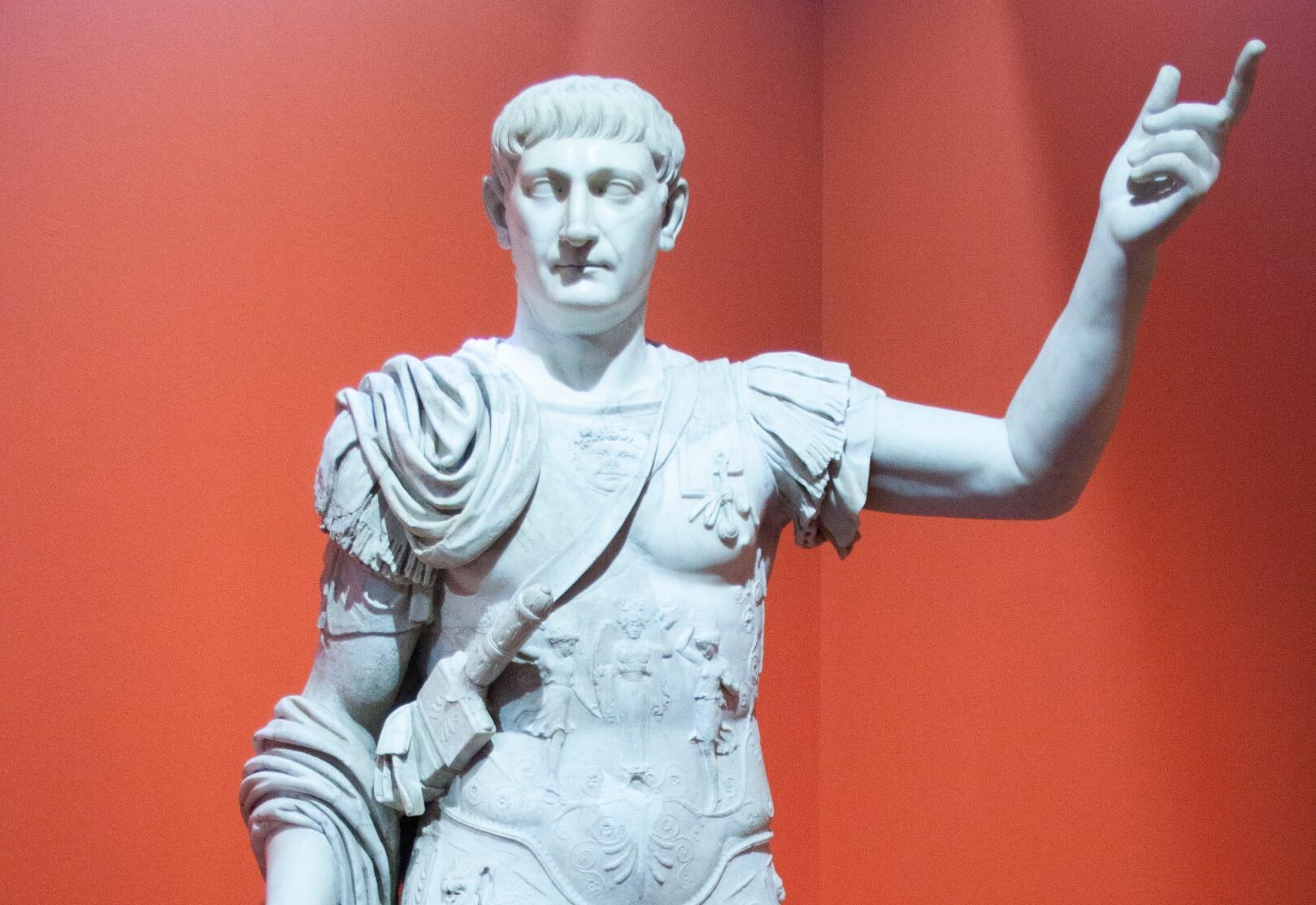
Ever wondered about the man behind some of Rome's most iconic monuments? Trajan, Rome's 13th Emperor, is a figure shrouded in both glory and mystery. Why does he stand out in the annals of history, you ask? Well, his reign marked the peak of the Roman Empire's territorial expansion and introduced architectural marvels that still awe us today. From the majestic Trajan's Market to the towering Trajan's Column, his legacy is etched in stone, quite literally. But there's more to this emperor than meets the eye. His governance, military conquests, and contributions to Roman society are subjects of fascination for historians and casual learners alike. Let's dive into the 29 best facts about Trajan, revealing the man behind the marble.
Who Was Trajan?
Trajan, born in 53 AD in what is now Spain, was Roman Emperor from 98 AD until his death in 117 AD. Known for his successful military campaigns, he presided over the greatest expansion of the Roman Empire, reaching its maximum territorial extent by the time of his death. Trajan is also celebrated for his philanthropic endeavors and the extensive building programs across the empire, which included the construction of Trajan's Market, Trajan's Forum, and Trajan's Column in Rome, commemorating his victory in the Dacian Wars.
- Trajan was the first Roman emperor born outside of Italy, highlighting the empire's expanding cultural diversity.
Trajan's Military Achievements
-
His conquest of Dacia (modern-day Romania and Moldova) was among his most significant military achievements. This victory brought vast amounts of gold and silver into the Roman treasury, strengthening the empire's economy.
-
Trajan led a successful campaign against the Parthian Empire, capturing the capital Ctesiphon in 116 AD. This expanded Roman influence into the Middle East, although many of these gains were short-lived after his death.
Public Works and Administration
-
Trajan is renowned for his extensive public building projects throughout the Roman Empire, which included roads, bridges, aqueducts, and buildings. These projects not only improved the infrastructure but also provided employment for many citizens.
-
He implemented a welfare program known as "alimenta" to assist orphans and poor children throughout Italy, showcasing his concern for the welfare of his people.
-
The construction of Trajan's Market, considered by some as the world's first shopping mall, featured multiple levels and over 150 outlets that sold everything from spices to clothing.
Trajan's Column
-
Erected in 113 AD, Trajan's Column stands as a monument to commemorate his victory in the Dacian Wars. The column is famous for its spiral bas relief, which depicts the story of the campaign in exquisite detail.
-
The column is over 30 meters (about 98 feet) in height and remains one of the most significant examples of Roman monumental sculpture.
Trajan's Legacy
-
Trajan is remembered as one of the "Five Good Emperors" of Rome, a term coined by Machiavelli that refers to five emperors who ruled successively and were noted for their virtuous governance.
-
After his death, the Senate officially declared Trajan "optimus princeps," meaning the best ruler, a title no other emperor had received before him.
-
His adoption of Hadrian as his successor, who would continue many of his policies and projects, ensured a smooth transition of power, a rarity in Roman imperial history.
The Expansion of the Roman Empire
-
Under Trajan, the Roman Empire reached its largest territorial extent, encompassing parts of modern-day Britain, Egypt, and the Middle East.
-
The annexation of Nabatea under his rule in 106 AD turned the wealthy trading kingdom into the Roman province of Arabia Petraea, facilitating trade routes to the East.
Trajan's Influence on Roman Society
-
Trajan's rule is often seen as the golden age of the Roman Empire, a period of relative peace, economic prosperity, and architectural achievements.
-
His policies and military conquests significantly increased the empire's wealth, allowing for the funding of his ambitious building projects and welfare programs.
-
The alimenta program not only provided food and financial assistance to the needy but also boosted the economy by increasing consumer spending.
Remembering Trajan Today
-
Trajan's Column, along with other structures like Trajan's Market and Trajan's Forum, continue to be significant tourist attractions in Rome, drawing thousands of visitors each year.
-
His legacy is also preserved in numerous ancient texts, coins, and monuments, providing valuable insights into Roman history and culture.
-
Modern historians and scholars often regard Trajan as one of the greatest Roman emperors, whose policies and achievements set a high standard for his successors.
-
Despite the passage of nearly two millennia since his reign, the impact of Trajan's rule is still evident in the architectural and cultural landscape of Rome and beyond.
-
Trajan's approach to governance, focusing on the welfare of his subjects and the expansion of the empire through strategic military campaigns, remains a subject of study and admiration among historians.
-
His death in 117 AD marked the end of an era of expansion and prosperity for the Roman Empire, leading to a period of instability and conflict in the years that followed.
-
The alimenta program is considered one of the earliest examples of a state-sponsored welfare system, illustrating Trajan's innovative approach to social policy.
-
Trajan's adoption of Hadrian, who was not a direct relative, as his successor demonstrated his belief in meritocracy over hereditary succession, a relatively progressive stance for his time.
-
The success of Trajan's military campaigns, particularly in Dacia, provided Rome with resources that would support the empire's economy for decades.
-
His emphasis on public works and infrastructure development not only improved the quality of life for Romans but also served as a model for future leaders.
-
Trajan's benevolent rule and the prosperity it brought to the Roman Empire are often contrasted with the reigns of less effective emperors who followed.
-
The strategic importance of the territories conquered by Trajan, especially in the Middle East, underscored the Roman Empire's ambition to control key trade routes and resources.
-
Finally, Trajan's enduring legacy as a ruler who combined military prowess with a genuine concern for the welfare of his subjects sets him apart in the annals of history as a model of effective leadership.
A Final Glimpse at Trajan's Legacy
Trajan's reign left an indelible mark on Rome, shaping its destiny and leaving a legacy that still captivates us today. His architectural triumphs, like the Trajan's Market and Trajan's Column, stand as testaments to his vision and the prowess of Roman engineering. Beyond bricks and mortar, his policies fostered a period of prosperity, expanding Rome's borders to their greatest extent and enriching its cultural tapestry. Trajan's approach to governance, characterized by respect for the Senate and efforts to improve the common Roman's lot, set a benchmark for his successors. His reign, often hailed as the pinnacle of the Roman Empire, offers invaluable lessons on leadership and the enduring impact of benevolent rule. As we reflect on Trajan's contributions, it's clear his legacy isn't just etched in stone but woven into the very fabric of history.
Was this page helpful?
Our commitment to delivering trustworthy and engaging content is at the heart of what we do. Each fact on our site is contributed by real users like you, bringing a wealth of diverse insights and information. To ensure the highest standards of accuracy and reliability, our dedicated editors meticulously review each submission. This process guarantees that the facts we share are not only fascinating but also credible. Trust in our commitment to quality and authenticity as you explore and learn with us.


